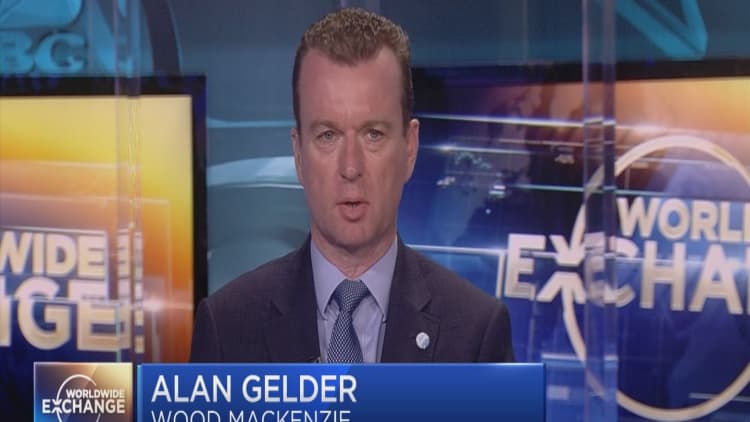Oil prices tumbled as much as 3 percent on Thursday, pulling back sharply after rallying to four-year highs on concerns about the fallout of U.S. sanctions on Iran, OPEC's third biggest crude producer.
International benchmark Brent crude futures fell $1.65, or 1.9 percent, to $84.64 a barrel by 2:29 p.m. ET. The contract hit a nearly four-year high of $86.74 on Wednesday.
U.S. crude futures ended Thursday's session down $2.08, or 2.7 percent, at $74.33, after hitting $76.90 on Wednesday, the highest level since November 2014.
On Wednesday, Brent climbed to the most technically overbought level since February 2012, while WTI inched higher to the most overbought since January. The relative strength index of both contracts rose this week to above 70, a technical level often regarded as signaling a market that has risen too far.
"The market was a bit over-extended on a short-term basis," said Brian LaRose, senior technical analyst at ICAP-TA.
"I would need to see both $84.35 and $82.85 broken (for Brent) to suggest that something more than just a minor rest stop in an ongoing uptrend is likely to take place here."
Also weighing on oil prices, Cushing, Oklahoma, crude inventories rose about 1.7 million barrels from Sept. 28 to Tuesday, traders said, citing a report from market intelligence firm Genscape.

The market is now just one month away from the Trump administration's Nov. 4 deadline for crude importers to stop purchasing Iranian barrels. Analysts tell CNBC the oil prices remain at risk of rocketing toward $100 a barrel until the market gets clarity about the ultimate drop in Iranian exports and the ability of oil producers to fill the gap.
"There's a lot of uncertainty right now. We don't have a clear picture on" Iran, Jeff Currie, global head of commodities research at Goldman Sachs, told CNBC's "Squawk on the Street" on Wednesday.
"If you have a sustainable loss in Iran, $90 to $100 is a potential outcome here, but we don't know at this point what's going to happen to Iran."
Currie believes the rally has gone too far too fast, and forecasts Brent will settle back into a range of $70 to $80 a barrel before the year ends.
On Wednesday, Saudi Energy Minister Khalid al-Falih said the kingdom was pumping near record levels and would raise output in November. Saudi Arabia is one of the few countries with the ability to significantly raise output.

However, crude prices shrugged off Falih's announcement, as well as a massive 8-million-barrels rise in weekly U.S. crude stockpiles.
Wednesday's rally showed that traders are calling Saudi Arabia's bluff that it has enough spare capacity, said Tamar Essner, director of energy and utilities at Nasdaq Corporate Solutions.
The market "is pricing in a future problem (tight supplies) whereas data-dependent OPEC is reacting to current supply conditions (which are still adequate)," Essner said in an email.
— Reuters contributed to this story.


